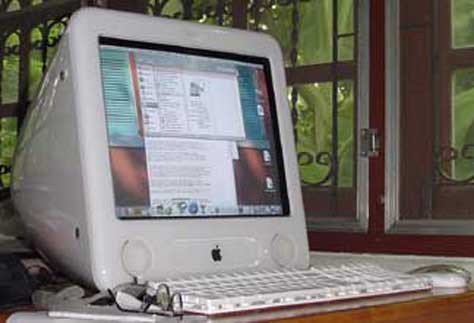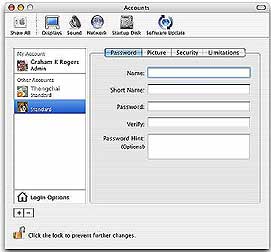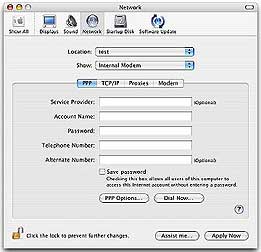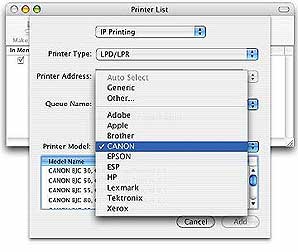
|

|
eXtensions
|
Saying Goodbye to my iMac |
I had been thinking of setting up a local area network (LAN) with the iMac and the eMac. I gave it some serious thought but came up with the question "What is the point?" Apart from backups, which I can do with other media, there seem to be few reasons to have a LAN, apart from impressing occasional visitors.
Once I had decided that a network was not part of my master plan, it seemed obvious that the iMac would go; but selling a 2-year old computer is a waste of time: transportation, negotiation, anticipation; and then resignation to the few thousand baht that might appear weeks or months down the line. I decided to give it away to a friend who had been particularly helpful.

|

|
I started by creating a new standard user account, then making this an Administrator account. I shut down, linked the two machines with a Firewire cable and restarted the iMac in Target mode. The friend and I then went through every part of my Home directory on the iMac to ensure that I had transferred all needed data.
When I was happy, we restarted the iMac in the new Administrator's account and, after a deep breath, deleted my account on that machine. In typical fashion, we were asked if we wanted the account removed and then if we really wanted to delete the account.

|

|
Creating the second admin account left all my Internet settings (dialup and office network) intact, so I cleared these too. Once home, my friend entered his data from Loxinfo and connected first time.
Once data was deleted, I had a careful look and removed some of the software. I had installed many programs as experiments. These applications were mainly odd little utilities that an unaware user might be tempted to try: the result would be late-night phone calls. Others were those (like LapCop) that could -- through legitimate internet connections -- cause alarms to go off. My friend needed a fairly stable environment to start with.
When I was satisfied with the cleanup, it was time to switch to instruction mode. People who start to use OSX are not facing the same environment as System 9 (some are still hanging on there) and it is certainly not the same as Windows. Some, however, expect everything to work the same and are horrified when, having deleted a couple of files that did not appear to be doing anything, OSX misbehaves.
Apple too does not appear to be forthcoming enough here either. It is left to people who write the books (or those who answer their phones) to get these folks out of trouble. If you dig deep enough into the Apple Knowledge Base (or the forums) answers can be found but people do this after they are in trouble, not before.
 After explaining the directory structures, I tackled what I consider to
be necessary maintenance routines. If you leave OSX on 24/7 these will
be run automatically. Most people either shut down or (like me) put
the computer to sleep: in these cases, the routines do not run.
After explaining the directory structures, I tackled what I consider to
be necessary maintenance routines. If you leave OSX on 24/7 these will
be run automatically. Most people either shut down or (like me) put
the computer to sleep: in these cases, the routines do not run.
I had left all the installers that I had downloaded on the iMac so put on MacJanitor, a fairly simple utility that is run with a couple of mouse clicks (on my own machine I have Macaroni, which does the tasks automatically). This also had the advantage of demonstrating the way disk images work.
I also demonstrated in Terminal how to run the same maintenance routines. For example, the daily run requires you to type in sudo sh /etc/daily (there are weekly and monthly too): each of these runs routines and clears logs. They can only be run from the Admin account and the administrator's password is required.
(Note: I wish users would do this, and run the following: these would save an awful lot of tears.)
I also consider it important regularly to run the process of repairing permissions. Using the Disk Utility this is fairly simple and just requires the click of a button. I run this at least once a week. I also run the process before and after installing new software. Some people may regard this as overkill. While running this process I realised just how much faster the eMac was. I also that importing music into iTunes from a CD was about 4 or 5 times faster.More processing power makes for a faster computer, of course.

|
I was keeping my printer, so we looked at the Printer Setup
Utility (in System Preferences or in the Utilities folder) and I
deleted my HP 920c. In "Add" (to confirm that his Canon was there) I
selected IP printers and ran through the list of drivers then
reselected USB printers. All that was necessary was to turn on the
printer, put in the USB cable and start Printer Setup: the printer was
installed automatically.
Armed with these basics, and with some experience of different operating systems, I reckoned that he was about ready to start the longer period of self-learning that a new computer initiates. I handed over the iMac and the original installation disks. As he left, I began to wonder about the latest PowerBooks and iBooks: a portable plus a desktop is a much better idea than a LAN. |

For further information, e-mail to Graham K. Rogers.
Back to
eXtensions
To
eXtensions: Book Reviews
To
eXtensions: Year Two
To
eXtensions: Year One
Back to homepage